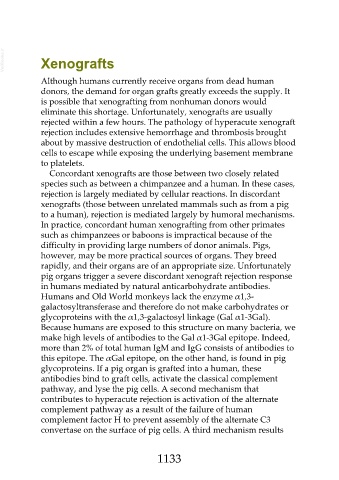Page 1133 - Veterinary Immunology, 10th Edition
P. 1133
VetBooks.ir Xenografts
Although humans currently receive organs from dead human
donors, the demand for organ grafts greatly exceeds the supply. It
is possible that xenografting from nonhuman donors would
eliminate this shortage. Unfortunately, xenografts are usually
rejected within a few hours. The pathology of hyperacute xenograft
rejection includes extensive hemorrhage and thrombosis brought
about by massive destruction of endothelial cells. This allows blood
cells to escape while exposing the underlying basement membrane
to platelets.
Concordant xenografts are those between two closely related
species such as between a chimpanzee and a human. In these cases,
rejection is largely mediated by cellular reactions. In discordant
xenografts (those between unrelated mammals such as from a pig
to a human), rejection is mediated largely by humoral mechanisms.
In practice, concordant human xenografting from other primates
such as chimpanzees or baboons is impractical because of the
difficulty in providing large numbers of donor animals. Pigs,
however, may be more practical sources of organs. They breed
rapidly, and their organs are of an appropriate size. Unfortunately
pig organs trigger a severe discordant xenograft rejection response
in humans mediated by natural anticarbohydrate antibodies.
Humans and Old World monkeys lack the enzyme α1,3-
galactosyltransferase and therefore do not make carbohydrates or
glycoproteins with the α1,3-galactosyl linkage (Gal α1-3Gal).
Because humans are exposed to this structure on many bacteria, we
make high levels of antibodies to the Gal α1-3Gal epitope. Indeed,
more than 2% of total human IgM and IgG consists of antibodies to
this epitope. The αGal epitope, on the other hand, is found in pig
glycoproteins. If a pig organ is grafted into a human, these
antibodies bind to graft cells, activate the classical complement
pathway, and lyse the pig cells. A second mechanism that
contributes to hyperacute rejection is activation of the alternate
complement pathway as a result of the failure of human
complement factor H to prevent assembly of the alternate C3
convertase on the surface of pig cells. A third mechanism results
1133

